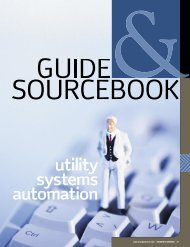asset management
asset management
asset management
Create successful ePaper yourself
Turn your PDF publications into a flip-book with our unique Google optimized e-Paper software.
Blending<br />
Solutions<br />
A GEORGIA CO-OP GOES “BEST-OF-BREED.”<br />
By Warren Causey<br />
Cobb Electric Membership Corp.(EMC), in Marietta, Ga.,<br />
is atypical of cooperative utilities in the United States. With its service<br />
territory located in one of the fastest-growing areas of suburban<br />
Atlanta, it’s larger than most co-ops with approximately 180,000 electric<br />
customers and more than 100,000 natural gas customers — all captured<br />
after the Georgia natural gas market was deregulated in July 1988.<br />
Cobb EMC also has morphed over the last 10 years from a traditional<br />
electric co-op to a multi-product company that sells everything<br />
from electricity and natural gas to local and long-distance telephone<br />
service, Internet service, home security, and more.<br />
To deal with its exploding list of services, Cobb EMC formed Cobb<br />
Energy Management Corp. (Cobb Energy) in 1997, a for-profit entity<br />
formed to be an aggregator of services for the membership of Cobb<br />
EMC and others.<br />
By 2003, it became obvious that Cobb EMC’s Orcom Customer<br />
Information System, which handled everything from financials and<br />
billing to tracking <strong>asset</strong>s in the field, needed updating.<br />
“That software really served us well through the years, but the<br />
way our company looked in 1995 [when the Orcom CIS was installed]<br />
and today is totally different,” says Steve Paolucci, associate vice<br />
president of finance at Cobb Energy. “The old monolithic software just<br />
couldn’t handle it anymore.”<br />
As a result of that impasse, Cobb Energy began exploring enterprisewide<br />
<strong>asset</strong> <strong>management</strong> software in 2003. In 2004, it began installing a<br />
new set of solutions. Most software and hardware for the entire enterprise,<br />
including the original co-op, now reside with Cobb Energy.<br />
“When we went into this project, we had hoped we could find one piece<br />
of software that could do everything we needed done,” Paolucci says.<br />
The fact that it didn’t work out that way is typical of many utilities<br />
in the United States — they haven’t been fertile ground for the large<br />
enterprise computing firms like Waldorf, Germany’s SAP.<br />
“We started with five or seven different options and narrowed it<br />
down to three: Lawson Software, St. Paul, Minn., PeopleSoft [now an<br />
Orcom subsidiary], and SAP,” Paolucci says. “We did intense sessions<br />
with those companies, gave them our requirements, and asked<br />
whether they could meet our needs out of the box, with minor modifications<br />
or major modifications.”<br />
42 ENERGYBIZ MAGAZINE July/August 2005<br />
That process, which was assisted by Capstone Consulting Partners,<br />
now a subsidiary of Alliance Data Systems, of Dallas, extended through<br />
last summer. However, none of the companies could satisfy Cobb Energy’s<br />
needs completely, Paolucci says. At that point, the utility decided<br />
to go with a “best of breed” solution. The result is the kind of mix-andmatch<br />
software selection that has driven executives of “enterprise”<br />
software firms up the wall and resulted in considerable consolidation.<br />
Cobb Energy will implement the following line-up of <strong>asset</strong> <strong>management</strong><br />
software:<br />
Lawson Software will handle financials and human resources/<br />
payroll.<br />
A new Cordaptix CIS from SPL WorldGroup, San Francisco, will<br />
be installed for customer care and billing.<br />
A component of Worksuite, of Houston, will provide the frontend<br />
for Cobb Energy’s existing field automation system.<br />
Intelliplant, a product of Information Intellect, of Marietta,<br />
Ga., will handle fixed <strong>asset</strong> <strong>management</strong> accounting for<br />
power and distribution <strong>asset</strong>s.<br />
“An EMC, like any distribution company, is pretty <strong>asset</strong> intensive, with<br />
most of the <strong>asset</strong>s being in transmission and distribution,” says Paolucci,<br />
explaining why there is a separate accounting system for fixed <strong>asset</strong>s.<br />
“Most generic accounting systems have one <strong>asset</strong> number for something<br />
such as a pole. Thus, they have to treat all those <strong>asset</strong>s individually. To<br />
avoid that, there are some specialty software systems that handle these<br />
things as groups. Information Intellect<br />
has one of those.”<br />
Cobb Energy now is installing<br />
and integrating all of the software.<br />
“We’ve been through three conversions<br />
so far,” Paolucci says. “We<br />
decided to try to learn from our<br />
previous mistakes — one of those<br />
was to run the projects ourselves.<br />
That’s why we hired Capstone. We<br />
wanted a company that had some<br />
expertise in managing a project for<br />
us so we could stay sort of on the<br />
outside and be more concerned<br />
with learning the software and<br />
training.”<br />
Despite the assistance, the<br />
installation is progressing in<br />
stages and won’t be fully<br />
completed until sometime in 2007,<br />
Paolucci says. When it is, Cobb<br />
Energy/EMC will join a long list<br />
of utilities that entrusts <strong>asset</strong><br />
<strong>management</strong> to a collection of<br />
best-of-breed software from<br />
several companies.<br />
definitions<br />
The following are offered<br />
as a guide.<br />
ERP – Enterprise Resource<br />
Planning<br />
ERP systems developed originally<br />
in heavy industry and tended<br />
to emphasize financials and<br />
resource planning, though they<br />
gradually grew to include work<br />
<strong>management</strong>, human resources,<br />
and other “softer” disciplines,<br />
including even customer information<br />
systems (CIS).<br />
EAM – Enterprise Asset<br />
Management<br />
EAM systems developed in more<br />
process-oriented industries with<br />
more emphasis on human resources<br />
and work <strong>management</strong>, but<br />
gradually grew to include financials<br />
and supply chain <strong>management</strong>/resource<br />
planning and CIS.<br />
SCM – Supply Chain<br />
Management<br />
SCM grew up in plants and<br />
factories and still concentrates<br />
primarily on the movement of<br />
parts, fuel, and other supplies<br />
within the heavy-industry supply<br />
chain. However, some SCM systems<br />
have grown to include other<br />
elements of ERP and EAM.



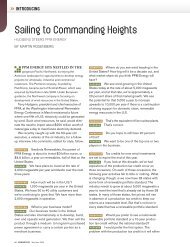
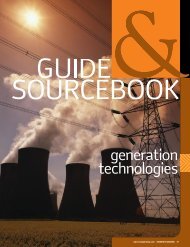
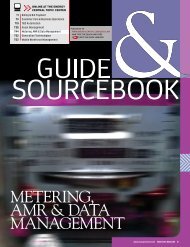

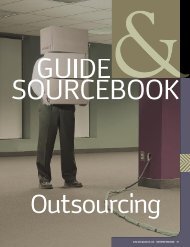
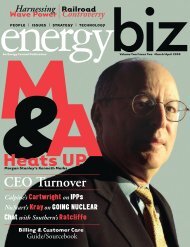

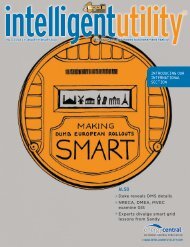





![View From the Trenches [PDF]](https://img.yumpu.com/18854438/1/190x252/view-from-the-trenches-pdf.jpg?quality=85)
